100 Places in Spain That You Have to Visit at Least Once
“Sun-drenched sandy beaches, sub-tropical forests, spectacular mountain ranges with peaks well in excess of nine thousand feet, volcanic regions, millennia-old cities and a seemingly endless amount of traditions waiting to be discovered. No, we’re not talking about far-off exotic locations – all this and much more awaits you within Spain’s borders. Spain is a fascinating country. If you still need convincing of this, we offer you a journey that is replete with curiosities, hidden-away nooks and crannies and a thousand and one ideas for activities to suit all tastes. City breaks, active tourism, natural beauty… Everything is possible in our list of 100 places to see and things to do in Spain. Believe me, it wasn’t at all easy whittling the list down to just 100!
100 Places in Spain You Have to Visit At Least Once
===================================================
### ANDALUSIA
1. Go for a swim off the idyllic beaches at Cabo de GatStunning beaches backed by majestic cliffs – this is what the volcanic activity at the dawn of time has bequeathed us at Cabo de Gata. Do what you want – relax on the sand, go kayaking or explore the marine environment. The choices are endless! To add a cultural touch to your trip, why not visit the abandoned farmhouse known as Los Frailes, the inspiration behind Federico Garcia Lorca’s famous play Blood Wedding.
2. Take in a concert at Sancti Petri castle
Just off the coast that runs between Chiclana de la Frontera and San Fernando is Sancti Petri castle, a defensive fort situated on a small island. As well as its historical importance, you will be pleased to learn that the island hosts numerous activities, from yoga and Zumba classes to exhibitions and concerts. Why not attend one of the many recitals that are given in the summer months and enjoy the explosion of colour at dusk as the sun goes down.
3. Go windsurfing and kitesurfing in Tarifa
Tarifa’s setting on the Strait of Gibraltar has given the town the name “the European capital of wind”, attracting water sports aficionados to this beautiful place. While it is true that many surfers are drawn to this spot on the Cadiz coast, experts also agree that Tarifa is the ideal place for wind sports enthusiasts. Whatever you choose to do, the pleasant temperatures here will make these beaches your favourites.
4. Relive the glories of Al-Andalus in Cordoba
Cordoba needs no introduction; nevertheless, not even the most alternative traveller should miss out on a visit to the city that was the capital of Muslim Iberia. The best starting point in order to get to know Cordoba’s Arab past is the magnificent sea of columns in the Great Mosque. Continue on to the Arab baths before concluding your visit at Medina Azahara, a vast ancient city that highlights the splendour of the Caliphate of Cordoba.
5. Be seduced by the sweet fragrance of Cordoba’s patios
May is the best month in which to enjoy the very essence of a holiday to Cordoba at its most authentic. This is when the city’s patios are opened up, allowing the fragrant aroma of carnations, geraniums and begonias to permeate the streets. The origin of the festival goes back to the early 20th century, although you may be interested to learn that the city’s patios date back to first the Romans and later the Arabs, who designed them to alleviate the heat of summer: first wells were added, to be followed by the floral decoration.

6. Take a journey through Lorca’s Granada
Rediscover Granada in the company of Federico García Lorca. Set off on a route dedicated to the poet and playwright, either one you design yourself or a guided tour led by an actor in character. Better than anyone, Lorca described the essence of his Granada – it is now your turn to discover the city to the rhythm of his most acclaimed verses. Not sure where to start? The Centro Federico García Lorca is an excellent point of departure.
7. Explore the white paradise of La Alpujarra
Between Granada and Almeria is the historical region of La Alpujarra. Its white villages dot the slopes of the Sierra Nevada, following in the footsteps of the Moriscos – former Muslim converts to Christianity – who lived in the area in the 16th century. Don’t miss villages such as Capileira, Órgiva, Lanjarón and Trevélez, spectacularly located at some of the highest altitudes in the Iberian Peninsula and offering stunning views.
8. Discover Doñana, Huelva’s natural paradise
Huelva has the good fortune to have the Iberian Peninsula’s largest wetland. This mosaic of ecosystems offers numerous routes through pine forests, sand dunes and marshes. Doñana’s amazing biodiversity is fascinating, with the park including a number of species that are in danger of extinction. The many activities available include hiking routes, such as the walk that takes you to the Acantilado del Asperillo fossil dunes, and hugely enjoyable boat trips that allow you to fully appreciate Doñana’s fauna in comfort.
9. Olive oil tourism in Jaén
Jaén and olive oil form an inseparable combination. You only have to set foot on the land here to realise the importance of “liquid gold” to local people. As far as the eye can see, there is what appears to be a sea of olive trees stretching to the horizon. A visit to an oil mill will reveal all the secrets of how olive oil is produced, allowing you to discover all there is to know about this key element in our diet.

10. Order a plate of fried fish in Malaga
The people of Malaga are affectionately known as “Boquerones” after the delicious fresh anchovies that are ubiquitous on the Costa del Sol. Don’t leave without ordering a plate of this local speciality – try the El Palo neighbourhood or head down to the beachside bars at La Malagueta. The sea breeze and the squawking of seagulls offer the perfect accompaniment to your meal.
11. Take a seat on a park bench in Seville’s Plaza de España
The Plaza de España in Seville is a hugely impressive monumental ensemble. Delight in its wonderful setting as you take a boat trip along the canal that runs around it or have a rest on one of the 48 benches dedicated to Spain’s provinces. Did you know that two are not represented here? One of these is due to the fact that the Canary Islands were divided into two provinces after the plaza was built while the other is Seville itself, as it appears in other murals.

12. The Madrugá – the longest night in Seville’s Holy Week celebrations
There are few things more impressive than Holy Week in Seville. The whole city celebrates Easter with whole-hearted devotion. The aroma of candle wax pervades the streets, while the beat of a drum announces that a penitential procession is about to pass as the mournful lament of the saetas give you goosebumps. The climax of the celebration is La Madrugá in the early hours of Good Friday which lasts into the morning. Make sure you don’t miss it, join the throng and become a part of the most intense night in Seville’s Holy Week.
### ARAGÓN
13. Discover Torla-Ordesa – the gateway to the Ordesa and Monteperdido National Parks
Many visitors come to Torla-Ordesa for its proximity to the Ordesa and Monteperdido valleys. Nevertheless, this medieval village with its charming slate-roofed stone houses is well worth a stay in its own right. Before you turn your gaze to Mondarruego, the imposing mountain that serves as a spectacular backdrop to the village as it turns a reddish colour at sunset, take a moment to observe the curious “witch-scarer” chimneys that are so characteristic of the Pyrenees in the Huesca region.

14. Spend a night in Albarracín, in the heart of Teruel
Albarracín has a spectacular historical centre, with its orange-reddish tones mirroring those of the mountain range of the same name in which it is set. Spend at least a night in this idyllic village – at dusk, as the lights begin to come on, the atmosphere is almost divine. It is then that a calm envelopes its narrow streets, with only the occasional the tolling of the church bell and the gentle sound of the River Guadalaviar accompanying your footsteps. Few things could be more appealing.

15. Take some stunning photos at the Monasterio de Piedra
Fill your social media with the most spectacular photos imaginable from your visit to the Monasterio de Piedra – the Stone Monastery. The fact that this park has been shaped by human hand makes it none the less impressive. The Cola de Caballo (“horsetail”) waterfall is the principal attraction – looking down on it from above will surely test your mettle! After visiting this beautiful park you will be left in no doubt as to why it is one of the main sights in the region.
16. Listen to old war and ghost stories in Belchite
Just 25 miles from Zaragoza are the ruins of the old town of Belchite. Walking through its long-abandoned streets can be an eerily breathtaking experience which gives you an idea of the impact of the Spanish Civil War. If you love ghost stories, you’re in luck – countless legends are set among the towns ruined stoned walls. You can listen to them during a night-time visit that will make your hair stand on end.
### ASTURIAS
17. Take part in the descent of the River Sella
Do you like to push your emotions to the limit? If you do, put your skill to the test by taking part in the International Descent of the Sella, a canoeing event that dates back to 1930. Every year in August, thousands of sportsmen and women canoe the 9-mile stretch of river between Arriondas and Ribadesella. If you prefer to leave the competition to others, there are numerous active tourism companies that offer river excursions that allow you to enjoy the Sella at your own pace.
18. Breathe in the mountain air on the shores of the Covadonga lakes
Fill your lungs with mountain air at the Covadonga lakes, which are of glacial origin. The two best known, Enol and Ercina, are at an altitude of over 3,700 feet and perfectly reflect the wild landscape that surrounds them. Breathe in the purest air in the Picos de Europa mountains and, if you are lucky enough to be in the area in Autumn, follow the route through the Palomberu beech forest: its ochre and tan tones will full reward your efforts.

### BALEARIC ISLANDS
19. Spend the day on the idyllic sun-kissed beach at Ses Illetes
Paradise is closer than you think. Look no further than the beach at Ses Illetes on the island of Formentera. Its crystal-clear waters are home to one of the Mediterranean’s most important ecosystems – the Posidonia meadows. Just a few hours on this beach won’t be enough, so relax with a good book on this stretch of white sand and enjoy the silence that is only broken by the sound of the breaking waves.
20. Take a mud bath in Ibiza
Every year, Ibiza’s beaches seduce a multitude of tourists with their unquestionable beauty, as does the island’s famous nightlife. Our suggestions represent an alternative that brings back the spirit of Ibiza’s hippy past: take a natural mud bath at one of the island’s beach spas. Numerous health-giving properties are associated with the mud from the nearby Pityusic Islands – now is your chance to find out for yourself. Where? At Aigües Blanques, Cala Xarraca and Sa Caleta.
21. Visit Sóller by train
Whoever said that travelling by public transport is boring? If you visit Mallorca, something as normal as a train ride can become a memorable experience. Palma and Sóller are joined by a railway line that crosses the Serra de Tramuntana mountains, offering spectacular views with the Mediterranean as a beautiful backdrop. There’s even more: did you know that this service, where time seems to stand still, began on the same day that the Titanic sank?

22. Enjoy Valldemossa’s rural charm
Get to know the genuine rural charm of this small village in the foothills of the Serra de Tramuntana mountains. The mountain peaks of the green Mediterranean forest contrast beautifully with the orange and brown colours of Valldemossa’s homes. The sea is nearby, with coves bathed by crystal-clear waters and a small port that still conserves its seafaring spirit. If it’s peace and quiet that you’re after, Valldemossa is undoubtedly the perfect spot.
23. Go horse riding in Menorca
Did you know that there is a breed of horses that is native to Menorca? Or that there is a path that runs along the length of the island’s coastline which you might just have heard of? These are the only ingredients you need to get to know the island in an unforgettable way: from the back of a Menorquín horse on the Camí de Cavalls.
24. Enjoy a day on the beach like a real Menorquín does
Menorca is a magnet for those in search of idyllic beaches. However, where should you start along its 135-mile coastline? Check out the south of the island, with its white sands and turquoise waters as seen at Macarella or the cove at Turqueta. For a wilder beach with the most crystal-clear waters imaginable, try the beach at Pregonda. A word of advice. If the wind is coming from the north, it’s better to go south. And if the wind is from the south? Head north!
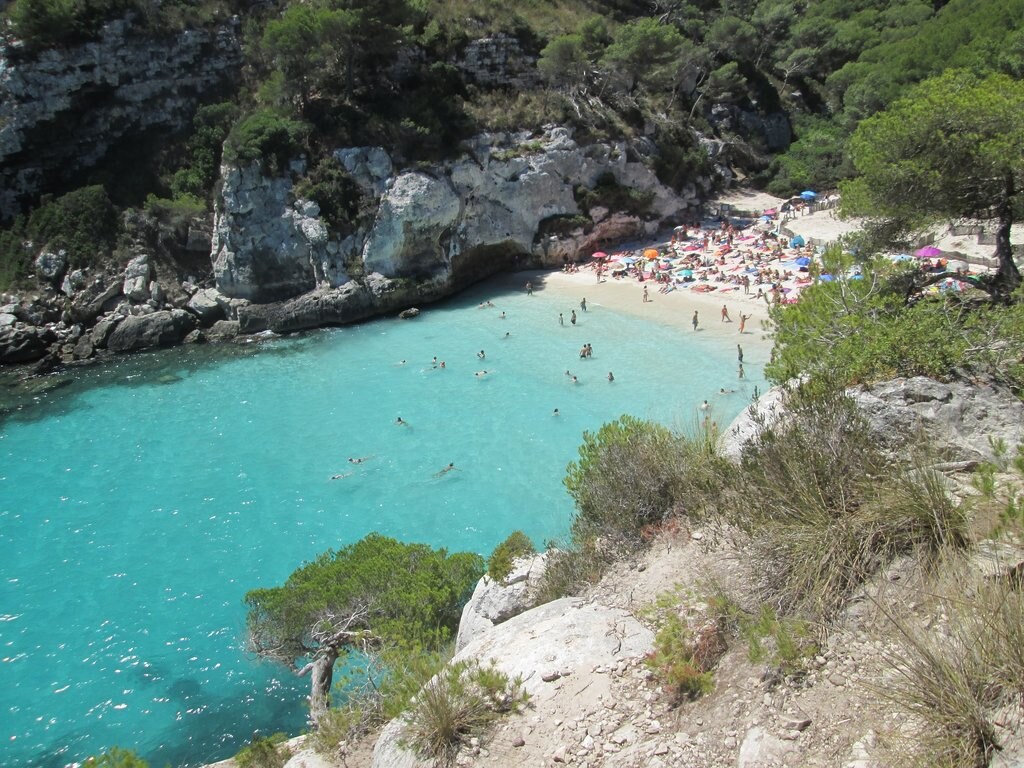
### THE CANARY ISLANDS
25. Bathe in the waters of the Charco Azul in El Hierro
Due to their peculiar terrain, the Canary Islands are blessed with numerous natural pools throughout the archipelago. On the island of El Hierro you can find one of the most fascinating – the Charco Azul. Volcanic lava and the erosion of the sea have slowly forged this almost fairytale landscape, where you can bathe in the turquoise waters inside a grotto.
26. Connect with the Majo past on the sacred Mount Tindaya
There is something mystical about the near-perfect pyramid that is the sacred Mount Tindaya, isolated amidst a vast plain. The ancient Majo people of the Canary Islands considered it a holy place, something that will be clear to you when you see the petroglyphs carved into the rock face that have survived the centuries. There is a hiking route that takes you to the top of the mountain, although on the way you may well want to pause at a quiet spot to take in the overwhelming calm that pervades the place and enjoy a good book.
27. Discover the wildest side of Fuerteventura – Cofete beach
Within Jandía natural park you can find Fuerteventura’s remotest beach. Cofete is the just reward for those adventurous souls willing to explore the most southerly point of the island. To call this a “virgin” beach falls well short: nearly eight miles of broad sands, crystal-clear waters and the rocky massif of Jandía as a backdrop all ensure that Cofete evokes nature at its very purest.
28. Take a walk at dusk along the Maspalomas sand dunes
It is common knowledge that the Maspalomas sand dunes are a truly singular natural space. The combination of desert and oasis in the form of a brackish lagoon make the area a magnet that draws in tourists from far and wide. Don’t let the crowds put you off though, the nature reserve stretches over a thousand acres. We recommend that you take in this unique landscape at dusk, when the sands gradually change colour as the sun sets over the horizon.
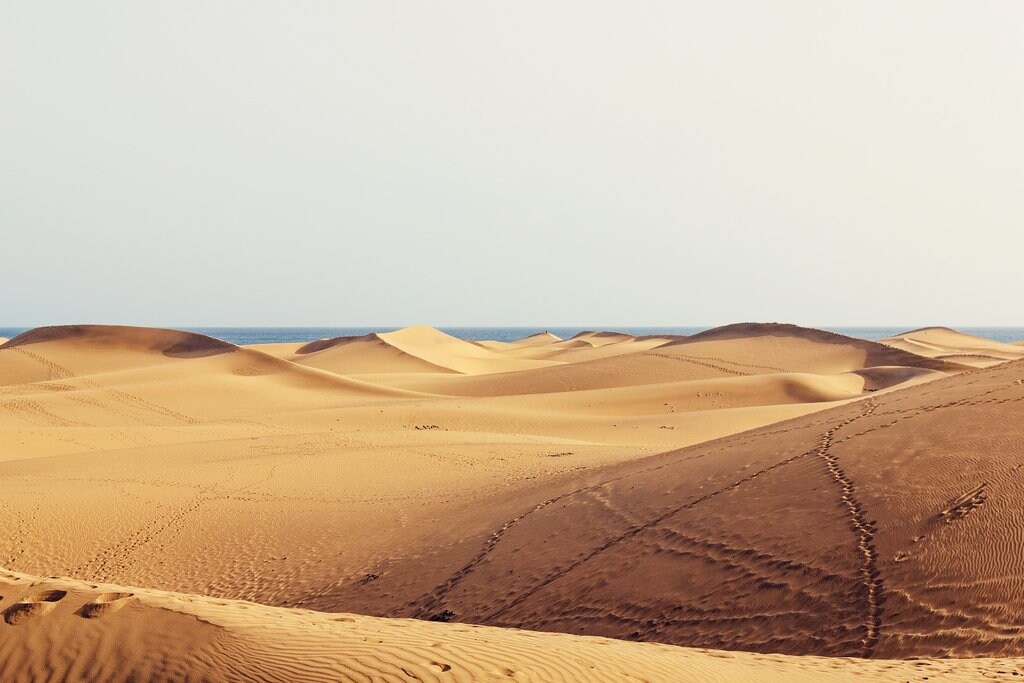
29. Discover the most festive side of the Vegueta neighbourhood
It is unthinkable that you visit Las Palmas de Gran Canaria and not go to the Vegueta neighbourhood. Here you will find Las Palmas’ main historical buildings and museums. As the sun sets, the area changes character and offers its liveliest face, with countless entertainment options that you will never tire of exploring. Bars, cellar restaurants and open-air terraces will all tempt you to tarry a while.
30. Garajonay – a landscape that will enchant you
Millions of years ago, laurel forests covered vast swathes of southern Europe. Very few remain today, although the island of Gomera is one such place where they can still be found. Take a stroll through the primitive forest of Garajonay and you will get the impression that you are entering an enchanted wood, with trees covered in moss and lichen which, in addition to the vines and creepers all around, paint this magical canvas the most intense green imaginable. You’ll find it impossible not to lose yourself on these wondrous paths!
31. Spend a romantic evening under the stars on the island of La Palma
As night falls on La Palma, you can’t help but turn your gaze to the skies, as the island brings together the ideal conditions that allow you to enjoy the wonderful world of astronomy. The Roque de los Muchachos Observatory, which stands an altitude of over 6,500 feet, is the perfect spot. Bring warm clothing, prepare a picnic and spend a romantic evening under the starlight. It will be an unforgettable experience.
32. Papagayo – Lanzarote’s finest beach
Let’s be honest. What would you most like to do in Lanzarote? Your answer will almost certainly be that you want to relax by the sea, which is perfectly understandable, seeing how the island has many incredible beaches. In the south of Lanzarote, Papagayo beach with its white sand and turquoise waters is considered to be the jewel in the crown. A further attraction is that the beach is part of the Ajaches natural park – pure, unspoilt nature within easy reach!
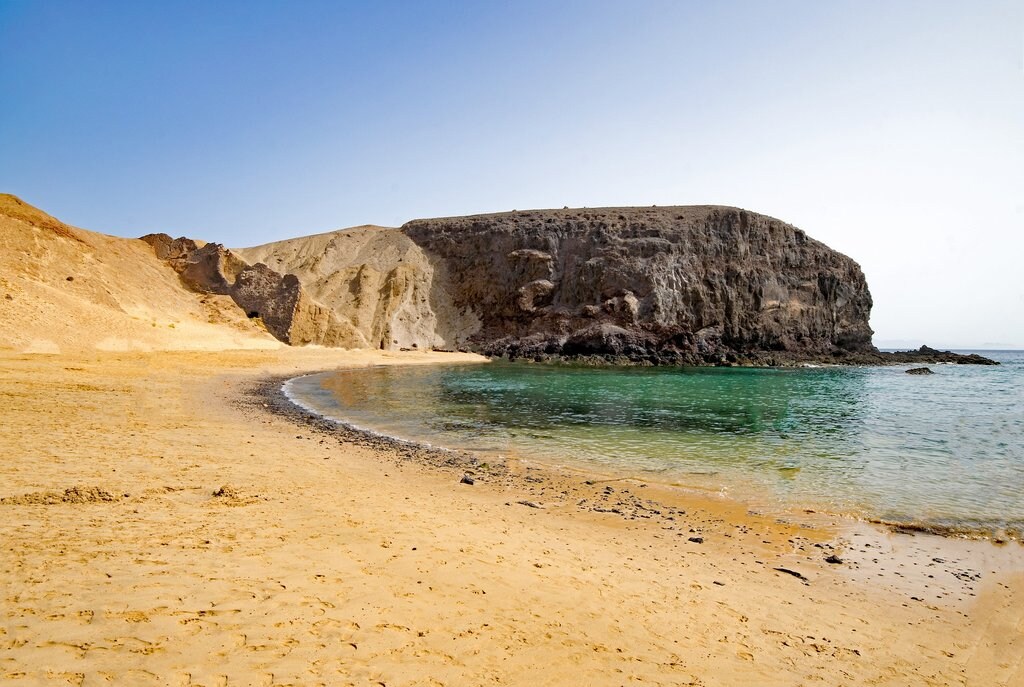
33. Go on a dolphin spotting trip in Lanzarote
Travellers increasingly want to be able to see animals in their natural habitat. If this is true for you and you are visiting Lanzarote, why not join a dolphin spotting excursion? Boats set off from Puerto del Carmen to take you to the areas where they are most commonly found. If you’re out of luck you can always plunge into the clear waters of the Atlantic and snorkel dive to the sea bed.
34. Conquer the summit of Mount Teide
Tenerife attracts numerous travellers who have only one idea in mind – to climb Teide. It’s no small feat, as Spain’s highest peak is a geological colossus. Reaching the top of the mountain is by no means easy, so if you are not at your fittest you can always take the cable car. It doesn’t matter how you do it, although it must be said, the hiking trail and lookout points are incredible. Remember the old saying: “The pleasure’s not in the arriving, it’s in the path you take to get there.”
35. Explore Icod de los Vinos, one of Tenerife’s most charming villages
Tenerife has many attractions, but if just one place deserves a place in your heart it should be Icod de los Vinos. The village is not only home to the Drago Milenario, the centuries-old dragon tree but also the Cueva del Viento (“Wind Cave”), a vast lava tube system that will take you into the heart of the island. If you are travelling with children, take them to the Mariposario butterfly house – they will be enthralled by the insects’ magical multicolour wings!
### CANTABRIA
36. Visit Santillana del Mar, possibly Cantabria’s greatest treasure
One of the jewels in Cantabria’s crown is Santillana del Mar. Known as the town of the three lies (a play on words on its name which suggests that it is saintly, flat and by the sea), Santillana del Mar is justly famous for the Altamira caves, which are considered to be the Sistine Chapel of prehistoric rock art. This, however, is not all – the old town, with its cobbled streets, historical buildings and balconies adorned with flowers offers visitors another journey into a forgotten past. One more thing before you leave: go into one of the town’s little shops and make your visit that bit sweeter with a delicious sobao – the local buttery sponge cake.
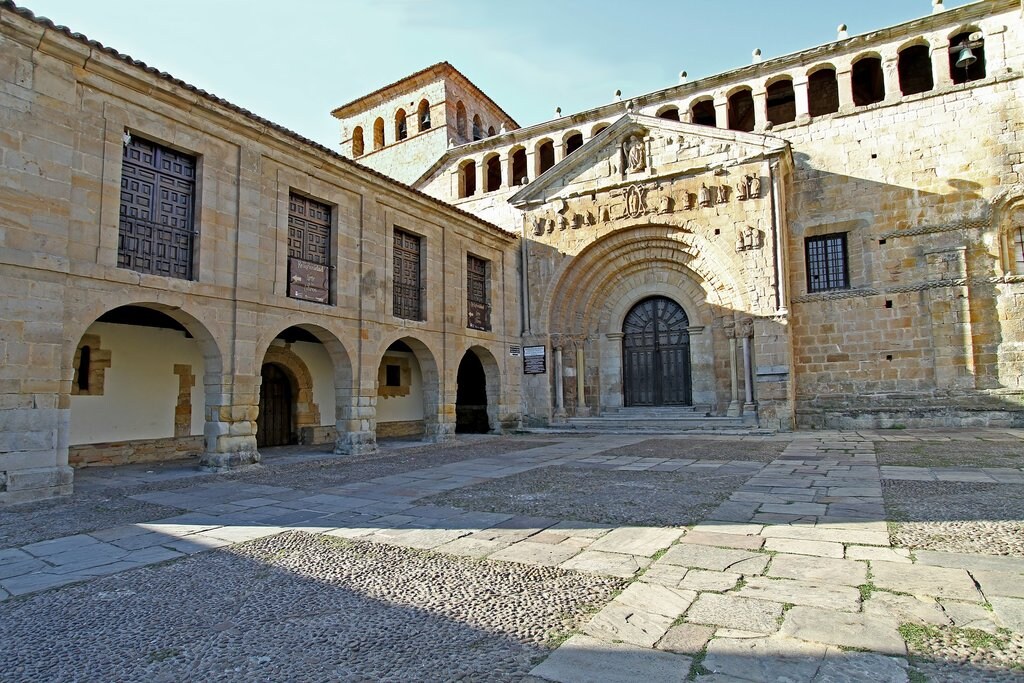
37. Comillas – discover Gaudí’s legacy beyond Catalonia
You don’t need to go to Barcelona to enjoy Gaudí’s genius. In the Cantabrian town of Comillas you will find the Villa Quijano, better known as “El Capricho”, the finest of its many modernist attractions. Look up at the wonderful tower-minaret with its stunning glass ceramic decoration. If you are luck and the sun is shining, the sparkling reflections can be dazzling.
### CASTILLA-LA MANCHA
38. Visit the source of the River Mundo
In the province of Albacete you can find one of Spain’s most beautiful natural phenomena – the source of the River Mundo in the Sierra del Segura mountain range, with its spectacular waterfalls and hazel, oak and pine forests. To see the waterfall in all its glory, make sure that your visit coincides with the so-called reventón, a sudden surge in the river flow. Don’t forget to wear an anorak, otherwise your clothes will end up soaked.
39. Attend a play in Almagro’s corral de comedias
Almagro is one of the most popular destinations in Ciudad Real. It’s past is closely tied into Spain’s theatrical history, and there is no better way to experience this than to attend a play at its corral de comedias traditional open-air theatre. This is the only theatre in the country that still has its original 17th-century structure. Take your seat and travel back in time to Spain’s “golden age”.
40. Let your imagination run riot in the enchanted Ciudad Encantada
Thousands of years ago saw the formation of the Ciudad Encantada – the “enchanted city”, a stunning natural park in the province of Cuenca in which enormous blocks of limestone began to take on amazing forms which seem to stretch up to the heavens. These millennia-old formations are the result of the erosion caused by both the wind and the water from the Cretaceous period. Use your imagination and see what shapes they suggest – we guarantee that your children will have a fantastic time!
41. Zaorejas – the finest place in Guadalajara to go for a swim
When the summer heat gets too much for you, there’s nothing better than to go for a cooling swim. Guadalajara is a long way from the sea; however, the bend in the River Tajo as it winds through Zaorejas offers beautiful spots in which to cool off. Today it might seem like the quietest place imaginable, but in years gone by it formed a part of the daily life of the gancheros, who took timber downstream to the sawmills.
42. Gaze upon the beauty of Toledo from the Ronda del Valle lookout point
There are few more impressive sights than that of Toledo from the Ronda del Valle lookout point. Here you will truly understand the city’s stately air, crafted over centuries by the skilled hands of the Celtiberians, Romans, Visigoths, Muslims and Christians. Toledo, the famous city of the three cultures, rises over a bend in the River Tagus. It is crowned by the imposing Alcázar, a centuries-old stone fortification that has witnessed many turbulent periods.
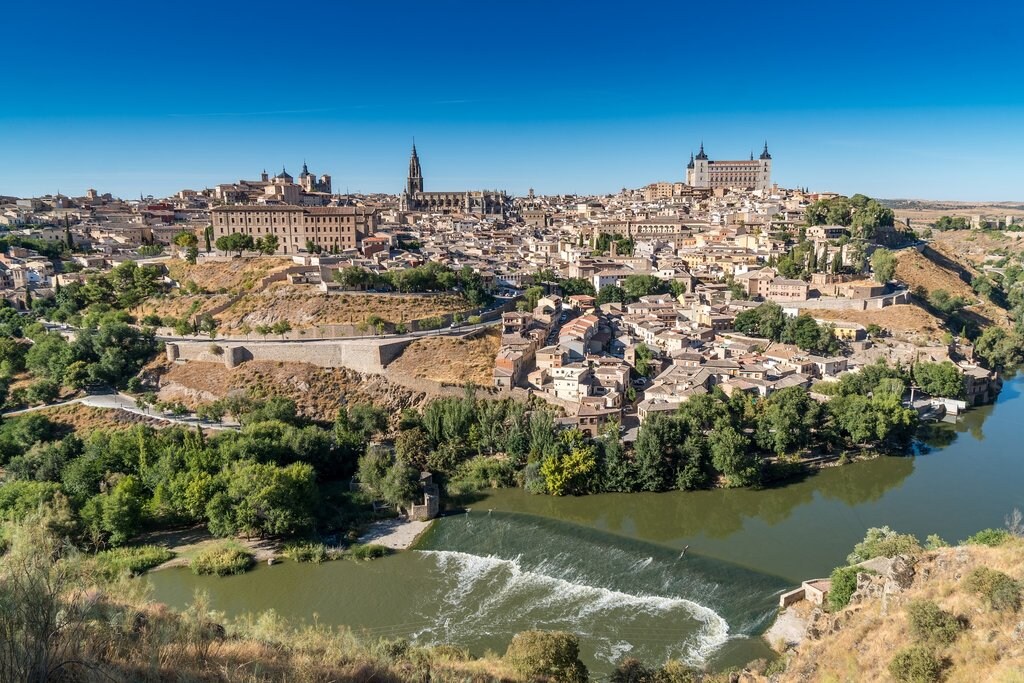
43. Walk in Don Quijote’s steps in Consuegra
Cervantes is Spain’s most internationally famous author thanks to Don Quijote. Countless visitors have come to this part of La Mancha to feel like the medieval knight who tilted at windmills astride his trusty steed Rocinante. If you were wondering where you should start, let us tell you: Consuegra. In the province of Toledo, its twelve windmills still preside over the village from the hillside of Cerro Calderico, an image which will be the envy of all your friends on social media.
### CASTILLA Y LEÓN
44. Take children to see Ávila’s city walls
Cultural visits with children can sometimes seem like mission impossible. In Ávila you will never have this problem. Its city walls are a Romanesque delight which will allow the youngest family members to imagine themselves heroes from the medieval era. They might need a bit of help to climb up to the battlements, but it’ll be worth it when you see the look of wonder on their faces as they take in the amazing views. The fact that at the entrance there’s a guide to the wall especially written with children in mind will really seal the deal.
45. Discover an Ávila that is the stuff of legend
Ávila breathes history from its every pore. Part of its charm lies in the countless legends concerning the city and the surrounding province. Why not get to know the city’s real character with a tour dedicated to local legend? Ávila has many to tell, especially to those brave enough to take the night tour – it’ll make the hairs on the back of your neck stand up!
46. Which do you prefer – cojonudos or cojonudas?
If you visit Burgos, you are bound to want to see its marvellous cathedral. Afterwards you will probably feel need to recharge your batteries in the city’s old town. In Calle de San Lorenzo you can try two of Burgos’s most typical tapas: the cojonudo, which features a fried quail’s egg, red pepper and chorizo on bread, or the cojonuda, where the chorizo is replaced with morcilla – the local black pudding. Pluck up the courage to ask about the dishes’ origins and how it got its curious name, which translates as “awesome”.
47. Uncover the enigmas of León cathedral
If you are on the Camino de Santiago – the Way of Saint James pilgrimage route – make sure you stop to visit León cathedral. This masterpiece of Gothic architecture will amaze you with its stunning array of medieval stained glass windows which filter the sunlight entering the cathedral, giving it a mystical, almost divine aura. However, it is not only the architecture that will astound you. León cathedral also hides a number of secrets that relate to alchemy and the occult sciences. Can you find them?
48. Visit a European bison nature reserve in San Cebrián de Mudá
When speaking of Castilla y León, our imagination conjures up the images of centuries-old cities about which there are countless myths and legends. Broaden your horizons by visiting San Cebrián de Mudá and hike, cycle, go horse riding or take an off-road vehicle and explore the hilly Montaña Palentina region In the European Bison Interpretation Centre you can find out all about this nature reserve project. Did you know that since 1927 there have been no free-roaming bison in Spain?
49. Take in the fascinating details of Salamanca’s New Cathedral
Salamanca’s New Cathedral is one of the final examples of Spanish Gothic architecture. You won’t be able to take your eyes of its towering steeple, although we recommend that you don’t stop there and instead seek out some of the cathedral’s most curious details: in the Puerta de Ramos portal’s stonework you will find two of the strangest elements imaginable. The best known is the carving of an astronaut, although if you look closely, you will also find a dragon eating an ice cream. How on earth did they get there?
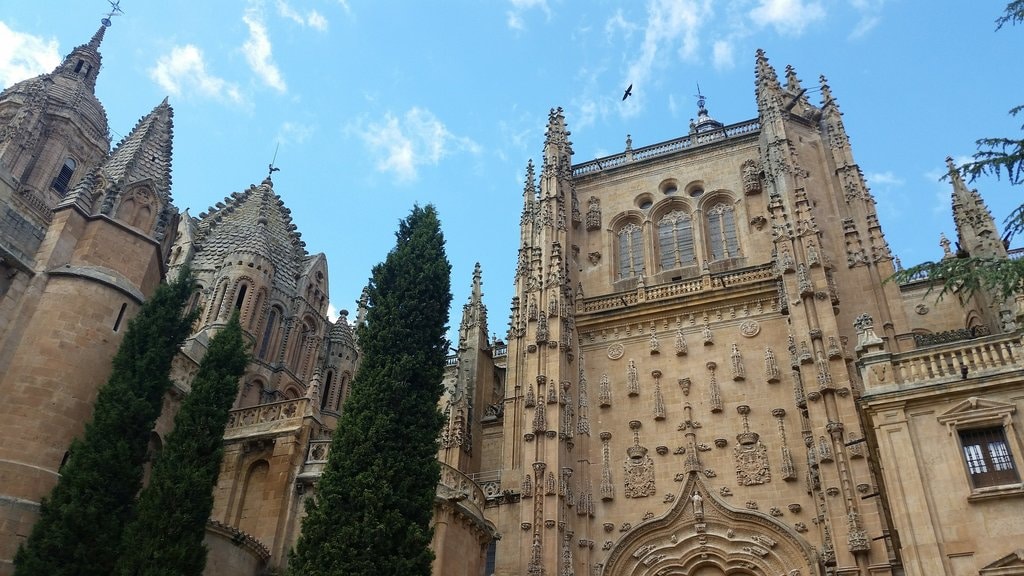
50. Have your photo taken with the devil by the Segovia aqueduct
Legend has it that a young woman, exhausted after a long trip to find water, asked the devil to build an aqueduct. If he could do so before the new day’s first ray of sunlight, she would give him her soul in exchange. However, just before he could place the final stone, the rising sun lit up his face. The gap in the wall now houses a statue of the Virgin Mary and, in honour of this legend, one of the devil next to the aqueduct. What will you ask of him?
51. Enter a traditional Segovian mesón and order a plate of suckling pig
If you really want to get to get to know a city, it is essential to understand its gastronomy. With this in mind, it’s unthinkable that you could visit Segovia without trying its roast suckling pig. The simplicity of the recipe is surprising, yet the result is nothing short of truly delicious. What may amaze you is the way that the edge of a plate is used to carve the meat. Today this tradition is maintained to show that the suckling pig is cooked to tender perfection.
52. Visit San Juan de Duero’s Romanesque cloister
When you come to Soria, don’t miss the San Juan de Duero monastery on the other side of the river. The highlight is its beautiful Romanesque cloister, an open-air medieval delight that allows visitors to walk in the warm sun with the Monte de las Ánimas hills as a backdrop. This wonderful setting inspired the poet and writer Gustavo Adolfo Bécquer to compose his famous legend dedicated to these hills.
53. Take part in a procession at Peñafiel’s medieval market
Do you like medieval markets? Then don’t miss the chance to visit Peñafiel, where local people transform this town in the province of Valladolid into a medieval village. Processions, games, craft workshops and, of course, re-enactments of episodes from history. Your visit to the market will take you back in time to medieval Valladolid, while the youngest members of the family will enjoy the displays of archery and birds of prey.
54. Get to know the Romanesque city of Zamora
While the province of Zamora has a number of marvellous villages, it is the capital that has the greatest number of Romanesque monuments on the Iberian Peninsula. Walking through Zamora is to open a doorway onto the Middle Ages, especially true in the case of the city’s cathedral. There is an old Spanish saying, “Zamora no se ganó en una hora” (“Zamora wasn’t conquered in an hour”), the local version of “Rome wasn’t built in a day”. It alludes to the heroic defence of the city during a seven-month siege in the 11th century.

### CATALONIA
55. Spend a fun day at Tibidabo, Spain’s oldest amusement park
Mount Tibidabo cuts through the Barcelona skyline, with the neo-Gothic Temple of the Sacred Heart of Jesus at the summit. Alongside is Spain’s oldest amusement park, which opened to the public in 1901. Take a ride on its roller-coaster, which offers the finest views over the city below, although nothing really compares to going on the park’s most famous rides, such as the Avión or “Aeroplane”, which has filled Barcelona’s sky with colour since 1930, or visiting its curious Automata Museum.
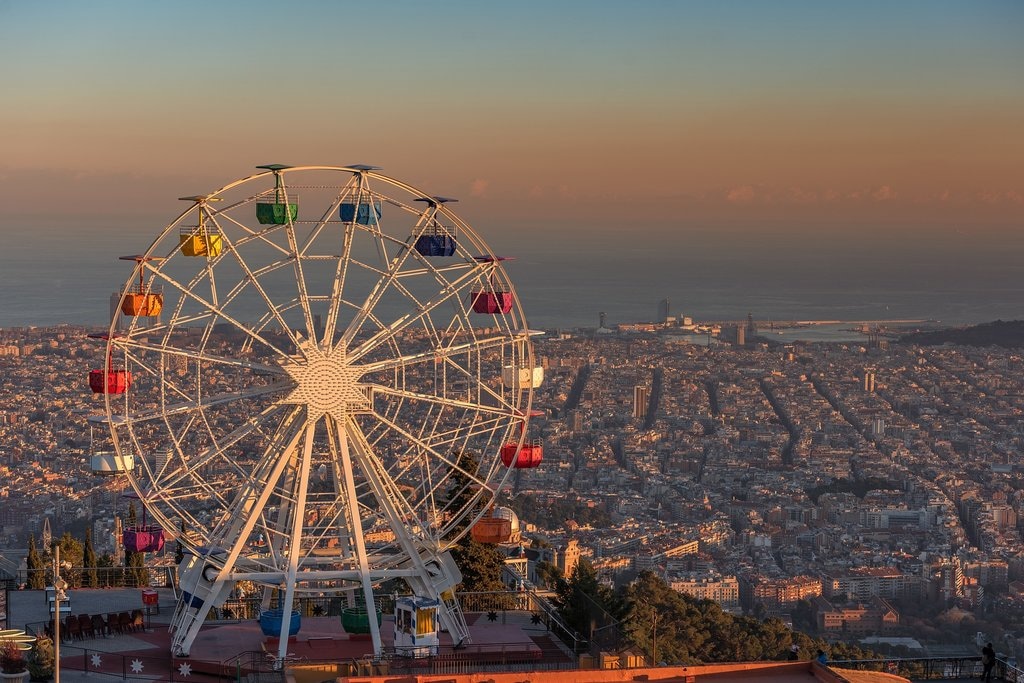
56. Set aside a Sunday morning to enjoy a relaxing vermouth in Barcelona
What goes around, comes around, something that is particularly true in the case of vermouth, a drink which is an absolute institution in Catalonia. When is the best time? That’s easy – a Sunday morning before lunch. Go into the street and look for a traditional bodega bar and ask for one with soda water. Have a little of whatever you fancy to accompany your vermouth – olives, cockles, vinegar-soused anchovies, crisps and so on. Any option is a good one in the lead-up to Sunday lunch.
57. Give somebody a rose or a book on Saint George’s day
Throughout Catalonia, 23 April is the feast day of Sant Jordi, the patron saint of the region, although in Barcelona the day
More Articles With Beach
Where to go for the ultimate work from home getaway
If you like to enjoy beach days away from the crowds, check out our list of the best hidden beaches in the UK.
For an old-school weekend by the sea, head to Skegness. Discover fish and chips, fairground fun and more with this three-day itinerary.
For fresh fish in crispy batter, served with salty, hand-cut chips, head to the seaside. Here are the best fish and chip shops in Skegness.
Discover the top attractions to explore in Mallorca during a holiday to plan your itinerary.